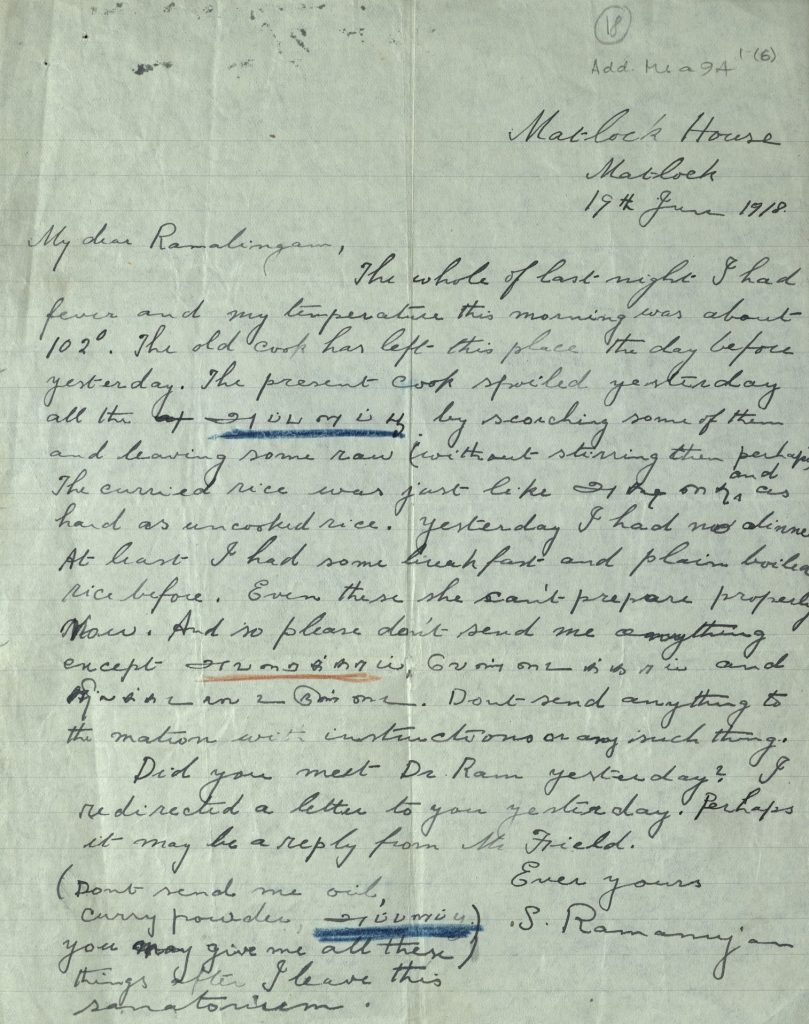German philosopher Arthur Schopenhauer observed in his 1818 masterwork The World as Will and Representation: “Talent is like the marksman who hits a target which others cannot reach; genius is like the marksman who hits a target … which others cannot even see.”
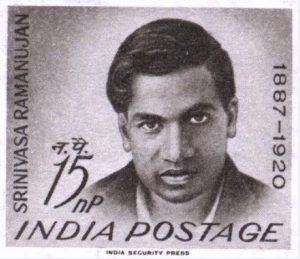
Ramanujan commemorative postage stamp issued in India in 1962. This was his passport photo taken in 1919 on his way back to India. “He looks rather ill,” G. H. Hardy wrote when he first saw the photo in 1937, “but he looks all over the genius he was” – Master and Fellows of Trinity College, Cambridge
These are the individuals who dedicate their lives to passionate journeys doing whatever it is they love to do – treating the universe as an interesting playing field. Nothing more, nothing less. One such individual is little-known, self-taught mathematician Srinivasa Ramanujan, who in his short lifespan of merely 32 years, made some revolutionary and surprising discoveries.
One day, the math teacher pointed out that any number divided by itself was one: Divide three fruits among three people, he was saying, each would get one…
So Ramanujan piped up: But is zero divided by zero also one? If no fruits are divided among no one, will each still get one?
This was Ramanujan’s question to his teacher when he was merely a the third grader. Robert Kanigel’s 1991 biography of Ramanujan, The Man Who Knew Infinity, from which the movie was later adapted, provides the most authentic account of Ramanujan’s early life.
Ramanujan performed his calculations as authentic as it gets — with chalk on slate, scrap paper, scribble on sand, whatever he could get his hands, or mind, on. His childhood best friend proclaimed him a genius the first time he walked in Ramanujan’s room, seeing all of the notes upon the walls. Unable to afford notebooks, he took to a large slate, using his own elbow as an eraser. “My elbow is making a genius of me,” Ramanujan would joke.
Being a genius of a certain order also comes with some penalties. Ramanujan’s unique obsession with mathematics made it especially difficult to fit in.
As Schopenhauer observed that individuals of extraordinary genius often fall victim to quite lonely course of life:
The common mortal, that manufacture of Nature which she produces by the thousand every day, is, as we have said, not capable, at least not continuously so, of observation that in every sense is wholly disinterested, as sensuous contemplation, strictly so called, is. He can turn his attention to things only so far as they have some relation to his will, however indirect it may be…
The man of genius, on the other hand, whose excessive power of knowledge frees it at times from the service of will, dwells on the consideration of life itself, strives to comprehend the Idea of each thing, not its relations to other things; and in doing this he often forgets to consider his own path in life, and therefore for the most part pursues it awkwardly enough.
By the time Ramanujan got to college, all he wanted to do was mathematics, failing all of his other classes. At one point, so frustrated with the seemingly arbitrary requirements of college, he ran away, causing his mother to send a missing-person letter to the newspaper:
![‘A Missing Boy', published on September 6, 1905 in s newspaper. It appeals for the public's help in tracing “a Brahmin boy of the Vaishnava (Thengalai) sect, named Ramanujam, of fair complexion and aged about 18 years” who had “left his [Kumbakonam] home on some misunderstanding.”](http://unboundintelligence.com/wp-content/uploads/2016/07/ramanujan-missing-boy-image.png)
‘A Missing Boy’, published in September, 1905 in a newspaper. It appeals for the public’s help in tracing “a Brahmin boy of the Vaishnava (Thengalai) sect, named Ramanujam, of fair complexion and aged about 18 years” who had “left his [Kumbakonam] home on some misunderstanding.”
As a college dropout from a poor family, Ramanujan’s future seemed bleak. He depended on the kindness of his friends and showcased his mathematical discovery-filled notebooks to patrons who just might support his work. When Ramanujan’s friends and acquaintances couldn’t land him a scholarship, Ramanujan started looking for jobs, working as an accounting clerk for the Port of Madras (now Chennai) in 1912.
Eventually, he wrote to mathematicians in Cambridge seeking validation of his work. Twice he wrote with no response; on the third try, he finally got an answer.
In 1913 a mathematician named G. H. Hardy in Cambridge, England received a package of papers with a cover letter that began:
Dear Sir,
I beg to introduce myself to you as a clerk in the Accounts Department of the Port Trust Office at Madras on a salary of only £20 per annum. I am now about 23 years of age….
and explained how he had made “startling” progress and solved the age-old problem of the distribution of prime numbers. Ramanujan concluded the letter with a heart-rending request:
Being poor, if you are convinced that there is anything of value I would like to have my theorems published…. Being inexperienced I would very highly value any advice you give me. Requesting to be excused for the trouble I give you.
Yours truly,
S. Ramanujan.
Something about the 11 pages of technical formulas made Hardy take a second look, and show it to his collaborator J. E. Littlewood. Hardy wrote,
Some of the formulae defeated me completely. I have never seen anything in the least like them before. A single look at them is enough to show that they could only be written down by a mathematician of the highest class.
After a few hours, they concluded that the results “must be true because, if they were not true, no one would have had the imagination to invent them.”
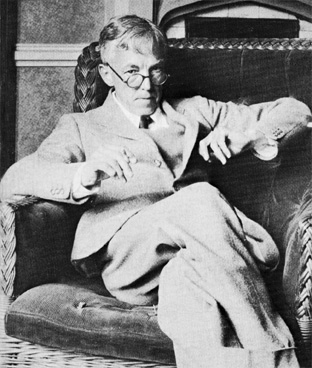
Godfrey Harold “G. H.” Hardy (7 February 1877 – 1 December 1947). In an interview by Paul Erdős, when Hardy was asked what his greatest contribution to mathematics was, Hardy unhesitatingly replied that it was the discovery of Ramanujan. He called their collaboration “the one romantic incident in my life.”
Hardy’s colleague, Bertrand Russell wrote that by the next day he “found Hardy and Littlewood in a state of wild excitement because they believe they have found a second Newton, a Hindu clerk in Madras making 20 pounds a year.”
In another letter to Hardy, Ramanujan confessed that he really just wanted someone to verify his results—so he’d be able to get a scholarship, since “I am already a half starving man. To preserve my brains I want food…”
Hardy wanted Ramanujan to come to England, which Ramanujan’s mother resisted as a matter of principle – high-caste Indians were not to travel to foreign lands. Luckily, she eventually agreed to let him go.
Ramanujan prepared for Europe with a new Western-inspired wardrobe, mastery of eating with knives and forks and learning how to tie a tie. He boarded a ship for England, sailing up through the Suez Canal, and arrived to London.
Although he tried his best to conform to the norms of the new society, his struggle to fit within the expectations of established academia seemed impossible. Ramanujan announced that he’d “changed [his] plan of publishing [his] results”. He said that since coming to England he had learned “their methods,” and was “trying to get new results by their methods so that I can easily publish these results without delay.”
The stark contrast between Hardy and Ramanujan is akin to that of many main-stream academicians and the true innovators who developed their own paths.
Hardy was no ordinary mathematician. He was credited with reforming British mathematics by bringing rigor into it. A man with natural affinity for numbers, Hardy’s papers were good examples of state-of-the-art mathematical craftsmanship. By 1910, Hardy had fell into a routine of normalcy as a Cambridge professor. He lived within the typical bounds of society while spending time practicing his mathematics.
Whereas, Ramanujan was a self-taught, poor Brahmin Indian with no formal education, who had a belief that fell far outside the bounds of organized study. He once told Hardy that, “A formula had no meaning unless it expressed a thought of God.”
While mathematicians in general were trained to systematically prove each of their theorems with extensive methodology, Ramanujan was a man of intuition. Once, Kaniglel writes, Ramanujan was asked about a new equation he had derived. His reply was that it was a Hindu goddess who had appeared in his dream and helped him solve that problem.
Hardy wrote:
Here was a man who could work out modular equations, and theorems of complex multiplication, to orders unheard of, whose mastery of continued fractions was, on the formal side at any rate, beyond that of any mathematician in the world … It was impossible to ask such a man to submit to systematic instruction.
[…]
so I had to try to teach him, and in a measure I succeeded, though I obviously learnt from him much more than he learnt from me.
When Hardy saw Ramanujan’s “fast and loose” approach to the infinite limits and the like, his reaction was a need to “tame” Ramanujan and educate him in the structured European methodology.
Rigor in analysis defined Hardy’s work, while Ramanujan’s results were (as Hardy put it) “arrived at by a process of mingled argument, intuition, and induction, of which he was entirely unable to give any coherent account.”
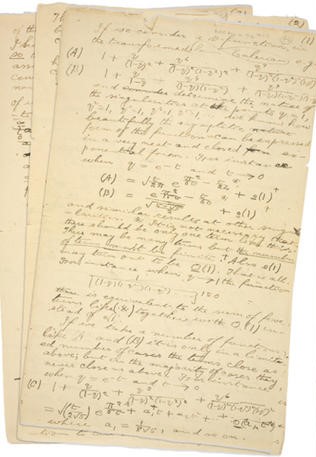
Pages from one of Ramanujan’s last letters.
As for his place in the world of Mathematics, Professor Bruce C. Berndt of the University of Illinois wrote:
Paul Erdos has passed on to us Hardy’s personal ratings of mathematicians. Suppose that we rate mathematicians on the basis of pure talent on a scale from 0 to 100, Hardy gave himself a score of 25, Littlewood 30, Hilbert 80 and Ramanujan 100.
Ramanujan couldn’t easily fit in the constraints of societal or academic expectations because his ideas were much bigger than the limitations imposed by convention.
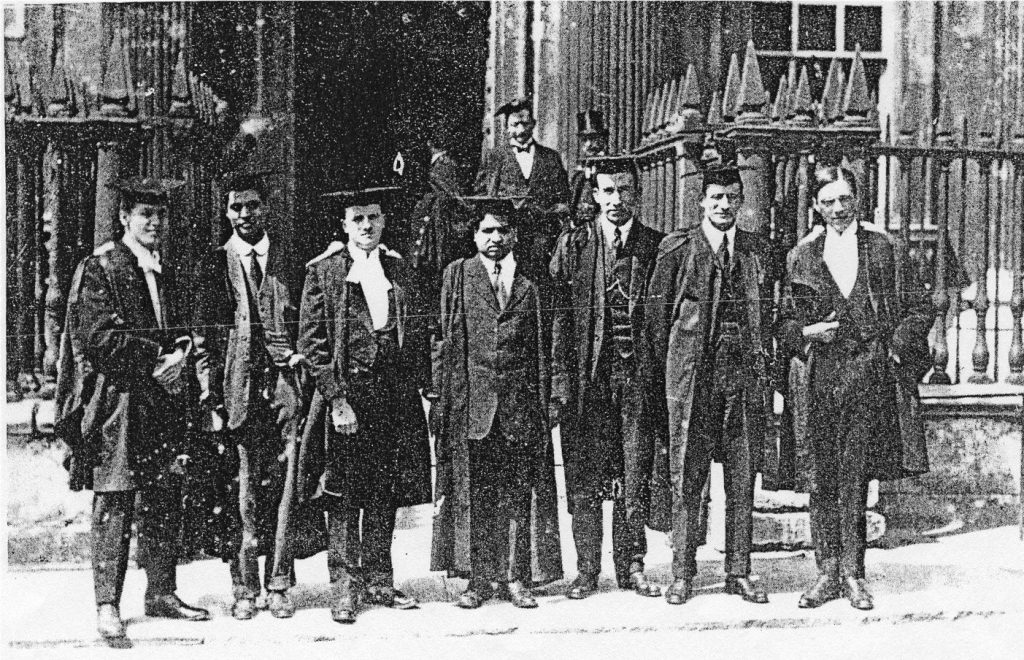
Ramanujan (centre) with other graduates at Trinity College in March 1916.
Hardy-Ramanujan’s collaboration in England was mathematically productive. Cambridge granted Ramanujan a Bachelor of Science degree “by research” in 1916, and he was elected a Fellow of the Royal Society (the first Indian to be so honored) in 1918. His accomplishments were followed quickly by a stark decline in his health as a result of the English winter and the difficulties of adhering to strict dietary rules of his caste in the face of wartime shortages. In 1917 he was hospitalized and nearly died. By late 1918 his health had improved; he returned to India in 1919. But his health failed again, and he died the following year year.
In reply to the above letter, his friend wrote:
My dear Ramanujan,
I was exceedingly grieved to have your painful letter. Sorry to hear that the new cook is a failure as far as you are concerned. Now then, I will have to be a bit harsh with you. I am impressed with you being so particular about your palate. But you’ll have to choose between controlling your palate and killing yourself.
Surely some of the greatest minds like Isaac Newton and Albert Einstein lived through their 70’s and 80’s, but their best works were actually produced in their 20’s. These were the individuals who didn’t count their life by the number of years lived, but the contribution they made to the advancement of human progress.
DOCUMENTARY ON RAMANUJAN – Mathematical Genius
A formula had no meaning unless it expressed a thought of God


